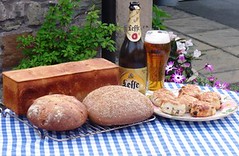ananda's blog
Some Weekend Home Bread Baking and the College "Equality and Diversity Competition" Entry from a student Bakery Group.
Equality and Diversity Competition
My Level 2 Bakery students are very competitive. Following on from Faye's Nettle Bread, and their determined, difficult yet successful adventures into Practical Exams, the group came up with a theme for their own entry into the College's Annual Competition:
"Breads of the World Arise"
See if you can name some of the breads, and where they come from?
Brief Report on the Young Baker Competition, and a weekend of Bread Baking at Home
It's been half term holiday week here; where has it all gone I'm asking, as I go back to work tomorrow.
I s to have spent much of the week working hard to tackle all the complex issues I have to deal with ready for next year.
A brief reflection on our trip to Bolton on Friday 18th February is quite calming and re-assuring that my job is a good one. Unfortunately Faye was not in the "prize money" on this occasion, but we both had a great day out, and were very well treated by our hosts.









